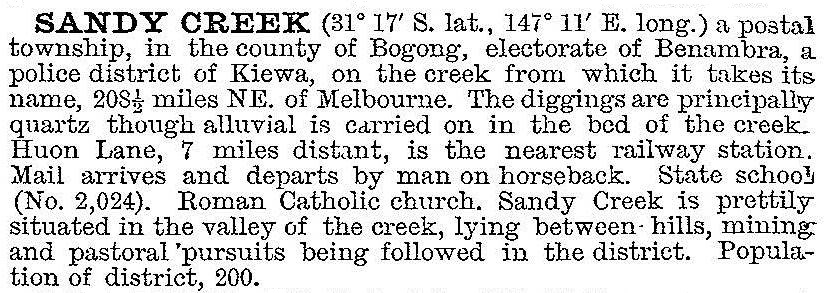Sandy Creek and Sandy Creek Upper
Sandy Creek is a tributary flowing northwards into Lake Hume in north-east Victoria. It has ranges on either side and the localities of Sandy Creek and Sandy Creek Upper are 4 km and 12 km respectively from the creek’s mouth.
Before the creation of Lake Hume, Sandy Creek flowed into the Mitta Mitta River which in turn entered the Murray River. Lake Hume in effect flooded the valleys at the junction of the two rivers. The Mitta Mitta River and several of its tributaries were the sites of gold discoveries in the early 1850s, and Sandy Creek’s gold was discovered in 1854. Contemporary reports put the diggings as extending about 5 km along the creek and they were occupied by about 300 miners. There was also some reef gold.
An Anglican school was opened in 1859. Unusual for gold towns there was apparently no hotel, little or no agriculture, and only a post office and the school by way of public institutions. Another unusual aspect of Sandy Creek was that the mining activity was maintained at an even or increasing level, and the school population reached 50 pupils by 1891. In 1903 Sandy Creek was described in the Australian handbook:

Gold and tin dredging functioned from about 1900 until 1918. The school was closed in 1921 and reopened in 1942 in the local hall. Final closure came in 1953 when Kiewa Consolidated was built. This left a substantial Catholic church, positioned on a hill overlooking the creek. Sandy Creek Upper school (1890) had 27 pupils in 1999 and 5 in 2014.
Sandy Creek and Sandy Creek Upper’s census populations have been:
| census date | population |
|---|---|
| 1911 | 227 |
| 1947 | 134 |
| 1961 | 156 |
Further Reading
Esther Temple, The Kiewa Valley and its pioneers, Kiewa Valley Historical Society, 1971


